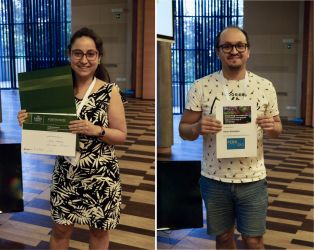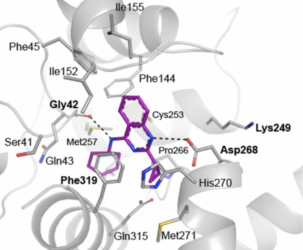News from the Institute

The IBC2 postdoctoral researchers Adriana Covarrubias and Alexis González both received a poster prize at the EMBO workshop “Integrating the molecular, mechanistic and physiological diversity of autophagy” which took place from 27 June until 01 July in Eger, Hungary.
... (read more)
The IBC2 chemical screening unit under the lead of Alexandra Stolz contributed to a study now published in Science. In the study, researchers from Karolinska Institutet and colleagues improved the function of a protein called OGG1, an enzyme that repairs oxidative DNA damage, implicated in ageing and diseases such as Alzheimer’s, cancer, and autoimmunity. The team examined how catalyst molecules, previously described by others, bind to OGG1 and affect its function in cells. One of the molecules proved to be of particular interest: it enabled the enzyme to cut DNA in an unusual way such that it no longer required its usual counterpart, APE1 to work, but relied on another protein called PNKP1. Potentially, OGG1 proteins improved in this way can be exploited as novel drugs for diseases in which oxidative damage is implicated.
... (read more)
IBC2 director Ivan Đikić has been awarded with an Advanced Grant of the European Research Council (ERC). This is the third time he receives the prestigious grant that comes along with research funding in the amount of € 2.5 million for the next five years.
With his grant, Ivan Đikić intends to unravel molecular mechanisms of endoplasmic reticulum (ER) remodelling via ER-phagy pathways. The endoplasmic reticulum (ER) is the largest intracellular membrane system and covers important functions in numerous processes. It is essential for cellular homeostasis and wellbeing. To fulfill its diverse functions, the ER is constantly adapting its shape, and Ivan Đikić is amongst the pioneers in shedding light on the regulation of these dynamic changes. He postulated that ER-phagy, a selective autophagy route targeting ER, is a major driver of ER remodelling and found first molecular cues on how this process is regulated.

Defects in SUMOylation have long been suspected as potential drivers of carcinogenesis, however, positive proof has been lacking. The post-translational modification of proteins with the ubiquitin-like modifier SUMO is known to regulate numerous essential cellular functions, and aberrant SUMO patterns have frequently been found in cancers. Now, a team of researchers around IBC2 Vice Director Stefan Müller and Ulrich Keller from Charité has identified the missing mechanistic link: They identified a tumor suppressing function for SUMO deconjugase SENP6, one of the enzymes responsible for reversion of SUMO modifications. In one third of B-cell lymphoma patients, SENP6 was found mutated or deleted. Loss of SENP6 was then in a next step shown to directly affect DNA repair and genome maintenance by destabilizing protein complexes involved in both essential pathways, ultimately leading to genome instability.
... (read more)
The great majority of mitochondrial proteins is encoded on the nuclear genome. As a consequence, translation of these proteins in the cytosol is followed by their translocation into mitochondria. Compromised mitochondrial protein import has been linked to various pathologies. Up to this point, investigation of protein import into organelles remained challenging due to a lack of suitable tools. The team around Christian Münch developed a proteomics-based assay that allows examining mitochondrial protein uptake at the global scale in unperturbed cells.
... (read more)